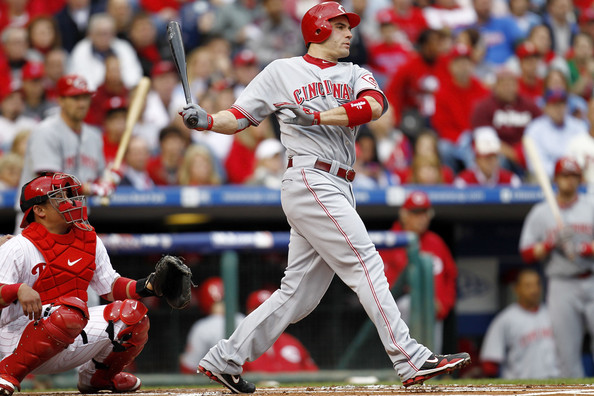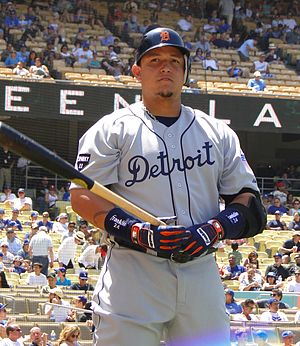
Though advanced statistics attempt to objectively tell you who the best players are, the winner of the MVP award is ultimately up to the sports writers that vote, and which statistics they tend to favor. Therefore, we must first determine which statistics define an MVP. Since the general consensus of baseball writers changes over time, only the last 5 MVP award winners from each league should be used as evidence.Table 1 shows the MVP award winners for each league over the last five seasons, and their league rank in each of the major standard statistics and WAR (Baseball Reference.com).
Before analyzing this data, a few adjustments must be made. Obviously, Verlander is a pitcher, unlike the others on this list; unless a pitcher manages to win the MVP award next year (the last pitcher to win one prior to Verlander was Eckersley in 1992), Verlander should be disregarded. Also Dustin Pedroia and Jimmy Rollins are statistical outliers in almost every category because they were not power hitters. Typically, MVP candidates are power-hitters so for the purpose of focusing on the right statistics, these two will be eliminated from the chart as well. Table 2 includes the adjustments.
With the new data set, some very clear patterns are evident. Quite clearly, every single one of these power-hitting MVPs from the last five years led the league in both SLG and OPS. Essentially, it appears as though the award will go to the winner of these two categories, barring some unforeseen pitching or non-power-hitting candidate. Interestingly, the player with the highest WAR in his respective league rarely won the award, showing that sports writers do not have complete confidence in this Sabermetric statistic. If writers truly believed this was a perfect statistical measurement of a player’s worth, then the award would go to the leader in this category every year. Now that we know sports writers tend to favor SLG and OPS, the next logical step is to predict who will lead the league in these statistics in 2012. OPS+ adjusts a player’s OPS to variables that could have proved favorable or unfavorable to him over the course of the season, and sets it to a 100 scale (100 is league average). Table 3 shows last year’s leaders in OPS+ in their respective leagues.
*moved from NL to AL
Most of next year’s candidates can be taken directly from this list. Suprisingly, Pujols is nowhere to be found on this list, but with an average OPS of 1.075 in the three seasons prior to last, he cannot be counted out. Whether Pujols’s underproduction was a result of aging or simply an “off-year” is hard to know for sure. Pujols, like Fielder will be moving from the NL to the AL.

With the given information, my AL choices can be narrowed down to the 5 players I feel are most likely to lead the league in OPS: Jose Bautista, Miguel Cabrera, Prince Fielder, Adrian Gonzalez, and Albert Pujols. It is hard to say how Pujols and Fielder will adjust to their new league, but both happen to be moving to slightly easier hitters’ parks (based on rotoworld park factors). Both, however, will need to adjust to the competition in the AL, which may hurt their statistics initially. Fielder will certainly benefit from Cabrera hitting in front of him, as Cabrera posted an outstanding .448 OBP, an astonishing .051 higher than Braun; however, Fielder’s averages with runners on base in his career are almost identical to his averages with the bases empty. As a result, Fielder’s SLG and OPS should not see a marked improvement. Though Pujols has inarguably been the best player in baseball over the last 5 years, his line drive rate has dipped below his career average in his last three seasons; as a result, his batting average finally dropped below .300 for the first time in his career. His walk rate also fell an astonishing 3.7% below his career average, lower than it has ever been. Sadly enough, Pujols might be past his prime, and his numbers should stay about where they were last season. Gonzalez is undoubtedly a great player, but he experienced a ridiculously high .380 BABIP last season, which was .058 higher than his career average. This could be due, in part, to the friendlier dimensions of Fenway or “lineup protection” but a .058 spike is too significant to have not involved some luck. A return to normalcy in BABIP will ultimately lower Gonzalez’s batting average, thus lowering his OBP and OPS in the process. Finally, that leaves only Miguel Cabrera and the enigmatic Jose Bautista. Though I firmly believed that Jose Bautista should have won the MVP last season, I have to give the edge to Cabrera. Bautista’s league leading OPS was due, in large part, to an absurdly productive first few months of the season. He posted an OPS of 1.170 in the first half and a .896 in the second, as he came down to earth. Bautista is an excellent baseball player, and one of my favorites, but he is incapable of keeping up the level of play that he showed the MLB in the first half of last season. And finally there is Miguel Cabrera, in my opinion, the best hitter in Major League Baseball. Since (ostensibly) overcoming his alcoholism two seasons ago,Cabrera has been a statistical monster.Over the last two seasons, Cabrera has averaged an OPS of 1.038 and has walked more than he has struck out, posting a BB/K of 1.21 (.16 higher than Pujols).With the Tigers poised to dominate the Central, Fielder coming to Detroit, and Cabrera entering his age-29-season, everything seems ideal for another solid campaign.Expect Cabrera to be as good, if not, better than he was last season and win the AL MVP award in 2012.
In the National League, the candidates are slightly less appealing. With Braun already out for 50 games and two of the best players (Pujols and Fielder) switching leagues, the National League MVP candidates are slim. Kemp and Votto seem like obvious candidates, and Mike Stanton and Justin Upton could certainly contend. Kemp was nothing short of amazing last season, as he produced throughout every statistical category while playing an offensively deficient position. Though he is too talented to call last year an anomaly, the advanced statistics suggest otherwise. His BABIP, like Gonzalez’s, was extremely high. The .380 mark he achieved last season was .028 points above his career average, but he did not switch ballparks or lineups as Gonzalez did; there are no explanations for the sudden increase beyond pure luck. His 23.1% K% was right around his career 23.4% average and his line-drive rate only rose slightly, so neither suffices to explain the spike in BABIP and batting average. I expect a decrease in Kemp’s SLG and OPS next season as his BABIP returns to where it should be. Mike Stanton may be the most powerful hitter in baseball. With an ISO of .275, he was first in the NL last season, and .013 higher than the next logical NL MVP candidate next season (Kemp). Having Reyes and a productive Hanley Ramirez batting in front of him will certainly improve Stanton’s statistics, as he will come to the plate with runners on base more often; however, he actually batted .048 lower with runners on base last year than he did when the bases were empty. Confusingly, he actually struck out 3.7% less in these situations, so I expect to see his luck to improve with runners on base. Stanton, however, has an embarrassing .42 BB/K ratio, that will make it hard for him to accumulate a tremendous OPS next season, even if he manages to hit 45 homeruns. Justin Upton, unfortunately, has the same problem, with a .47 BB/K last season. These two hitters simply strikeout too often and walk too little to improve to MVP status at this point in their careers; both are young, however, and will definitely contend in the foreseeable future. Finally we are left with Votto, who, with the sudden exodus of the NL’s best hitters, (Pujols, Fielder, Braun-ish) may now be the best hitter in his league. With a lifetime OPS of .955 and unquestionable consistency over the last few seasons, Votto is the most likely candidate. His .85 BB/K last year was markedly better than the previously mentioned candidates and there is no reason to believe we will see a dip in his batting average as his .349 BABIP last year was actually below his career average. A .950+ OPS next season, along with plenty of standard and advanced statistics to accompany it, should be more than enough to win the NL MVP award.
Works Cited:
Baseball Statistics and Analysis | FanGraphs Baseball.Baseball Info Solutions. Web. 31 Jan. 2012. <http://www.fangraphs.com/>.
Baseball-Reference.com – Major League Baseball Statistics and History.Baseball Info Solutions. Web. 31 Jan. 2012. <http://www.baseball-reference.com/>.
“MLB on Yahoo! Sports – News, Scores, Standings, Rumors, Fantasy Games.” Yahoo! Sports – Sports News, Scores, Rumors, Fantasy Games, and More.ABC News Network. Web. 31 Jan. 2012. <http://sports.yahoo.com/mlb;_ylt=AoUOlYeYlAhhl_Z1gncOJOw5nYcB>.
Gleeman, Aaron. “ESPN and RotoWorld Park Factors.” Advanced Fantasy Baseball.Rotoworld. Web. 31 Jan. 2012. <http://www.advancedfantasybaseball.com/2009/01/espn-and-rotoworld-park-factors.html>.










